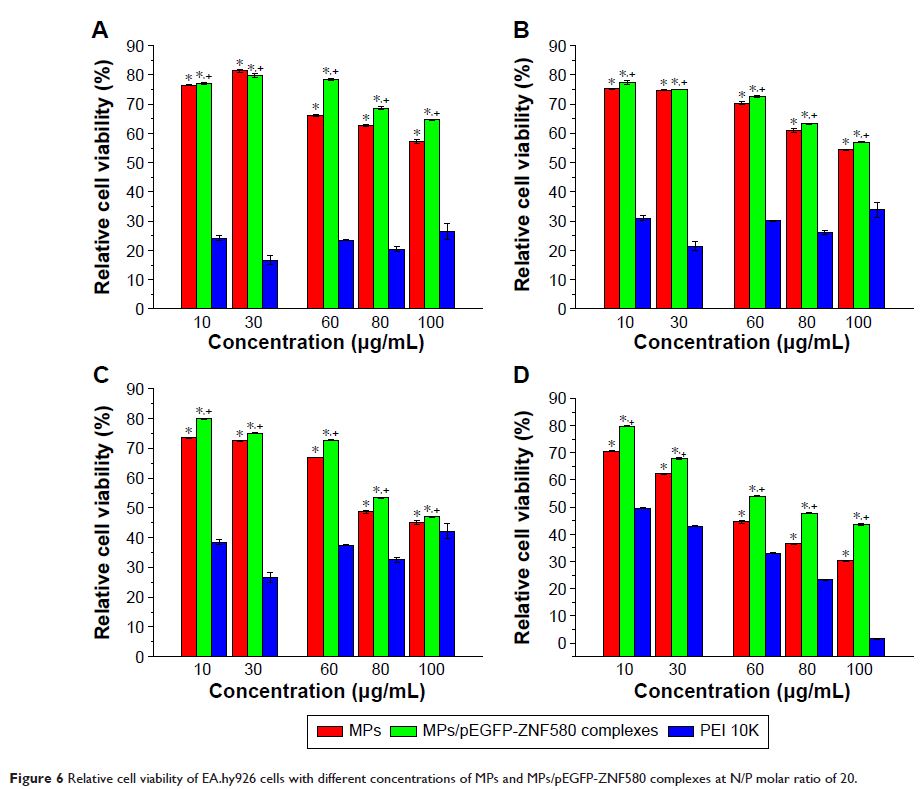108384
论文已发表
注册即可获取德孚的最新动态
IF 收录期刊
- 3.4 Breast Cancer (Dove Med Press)
- 3.2 Clin Epidemiol
- 2.6 Cancer Manag Res
- 2.9 Infect Drug Resist
- 3.7 Clin Interv Aging
- 5.1 Drug Des Dev Ther
- 3.1 Int J Chronic Obstr
- 6.6 Int J Nanomed
- 2.6 Int J Women's Health
- 2.9 Neuropsych Dis Treat
- 2.8 OncoTargets Ther
- 2.0 Patient Prefer Adher
- 2.2 Ther Clin Risk Manag
- 2.5 J Pain Res
- 3.0 Diabet Metab Synd Ob
- 3.2 Psychol Res Behav Ma
- 3.4 Nat Sci Sleep
- 1.8 Pharmgenomics Pers Med
- 2.0 Risk Manag Healthc Policy
- 4.1 J Inflamm Res
- 2.0 Int J Gen Med
- 3.4 J Hepatocell Carcinoma
- 3.0 J Asthma Allergy
- 2.2 Clin Cosmet Investig Dermatol
- 2.4 J Multidiscip Healthc

阳离子微粒的共自组装用于递送 pEGFP-ZNF580 以促进内皮细胞的转染和迁移
Authors Feng Y, Guo M, Liu W, Hao X, Lu W, Ren X, Shi C, Zhang W
Received 2 March 2016
Accepted for publication 4 September 2016
Published 20 December 2016 Volume 2017:12 Pages 137—149
DOI https://doi.org/10.2147/IJN.S107593
Checked for plagiarism Yes
Review by Single-blind
Peer reviewers approved by Dr Akshita Wason
Peer reviewer comments 2
Editor who approved publication: Dr Lei Yang
Abstract: The gene transfection efficiency of polyethylenimine (PEI) varies with
its molecular weight. Usually, high molecular weight of PEI means high gene
transfection, as well as high cytotoxicity in gene delivery in vivo. In order
to enhance the transfection efficiency and reduce the cytotoxicity of PEI-based
gene carriers, a novel cationic gene carrier was developed by co-self-assembly
of cationic copolymers. First, a star-shaped copolymer
poly(3(S)-methyl-morpholine-2,5-dione-co-lactide) (P(MMD-co-LA)) was
synthesized using D-sorbitol as an initiator, and the cationic copolymer
(P(MMD-co-LA)-g-PEI) was obtained after grafting low-molecular weight PEI.
Then, by co-self-assembly of this cationic copolymer and a diblock copolymer
methoxy-poly(ethylene glycol) (mPEG)-b-P(MMD-co-LA), microparticles (MPs) were
formed. The core of MPs consisted of a biodegradable block of P(MMD-co-LA), and
the shell was formed by mPEG and PEI blocks. Finally, after condensation of
pEGFP-ZNF580 by these MPs, the plasmids were protected from enzymatic
hydrolysis effectively. The result indicated that pEGFP-ZNF580-loaded MP
complexes were suitable for cellular uptake and gene transfection. When the
mass ratio of mPEG-b-P(MMD-co-LA) to P(MMD-co-LA)-g-PEI reached 3/1, the
cytotoxicity of the complexes was very low at low concentration
(20 µg mL-1). Additionally, pEGFP-ZNF580
could be transported into endothelial cells (ECs) effectively via the complexes
of MPs/pEGFP-ZNF580. Wound-healing assay showed that the transfected ECs
recovered in 24 h. Cationic MPs designed in the present study could be
used as an applicable gene carrier for the endothelialization of artificial
blood vessels.
Keywords: star-shaped copolymer, microparticles,
gene carrier, endothelial cells, transfection, migration
